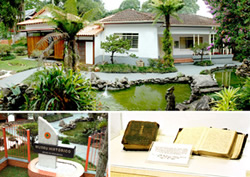Seicho-No-Ie Brazil Historical Museum Opened
To Pass on the Predecessors' Will to Future Generations

SNI Brazil Historical Museum opened last year
Last November, Seicho-No-Ie Brazil Historical Museum was opened on the premise of the South American Spiritual Training Center in Ibiuna, Sao Paulo. Over a six-month period it was visited by over 4,000 followers.
The Museum, built in recognition of the great work of the predecessors who contributed to the Seicho-No-Ie Humanity Enlightenment Movement in Brazil, is intended to pass on their will to future generations. On display are various commemorative goods and picture panels, as well as explanations in three languages (Portuguese, Spanish and Japanese) to help visitors from Central South American countries understand.
The facility, which used to be the house of the late Rev. Miyoshi Matsuda, the first Bishop of Seicho-No-Ie Latin America, was completely refurbished for this purpose. It has 327.32 square meters in floor space on a 1,360 square meter premise. It consists of two buildings: the one-story building which has seven rooms; and another building adjacent to it called Koryoso, where Dr. and Mrs. Masaharu Taniguchi stayed in 1962 and 1973 when they visited the country.
There are 60 exhibits, including the leather-cover Seimei no Jisso (Truth of Life), which the late Matsuda brothers, Daijiro and Miyoshi, owned; the leather-cover Seimei no Jisso, copies of which the father of the current Bishop, Rev. Yoshio Mukai, bought in Japan in 1936 and lent out to Japanese immigrants, which helped spread Seicho-No-Ie; the Holy Sutra, Nectarean Shower of Holy Doctrines, the translation of which was published for the first time in the 1950’s; and the first published copy of the Portuguese-version Seicho-No-Ie magazine. In addition, there are 80 picture panels showing a record of the Movement since the 1940’s. There are many materials of very important historical value, which are indispensable in learning about the history of the Humanity Enlightenment Movement in Brazil.
Rev. Marie Murakami,Vice Chairman of the Brazil Missionary Headquarters, who headed the Historical Museum Construction Committee, remarked: “Many of the people who lived in the initial stage of the Seicho-No-Ie Movement in Brazil have already passed on to the spiritual world and I am afraid that in several years much of the important information and valuable historical material might be lost. The construction of the Historical Museum was made possible by the sincere contribution of many people. Their contribution will live in the memories of future generations, just like the glow of those exhibits.”
